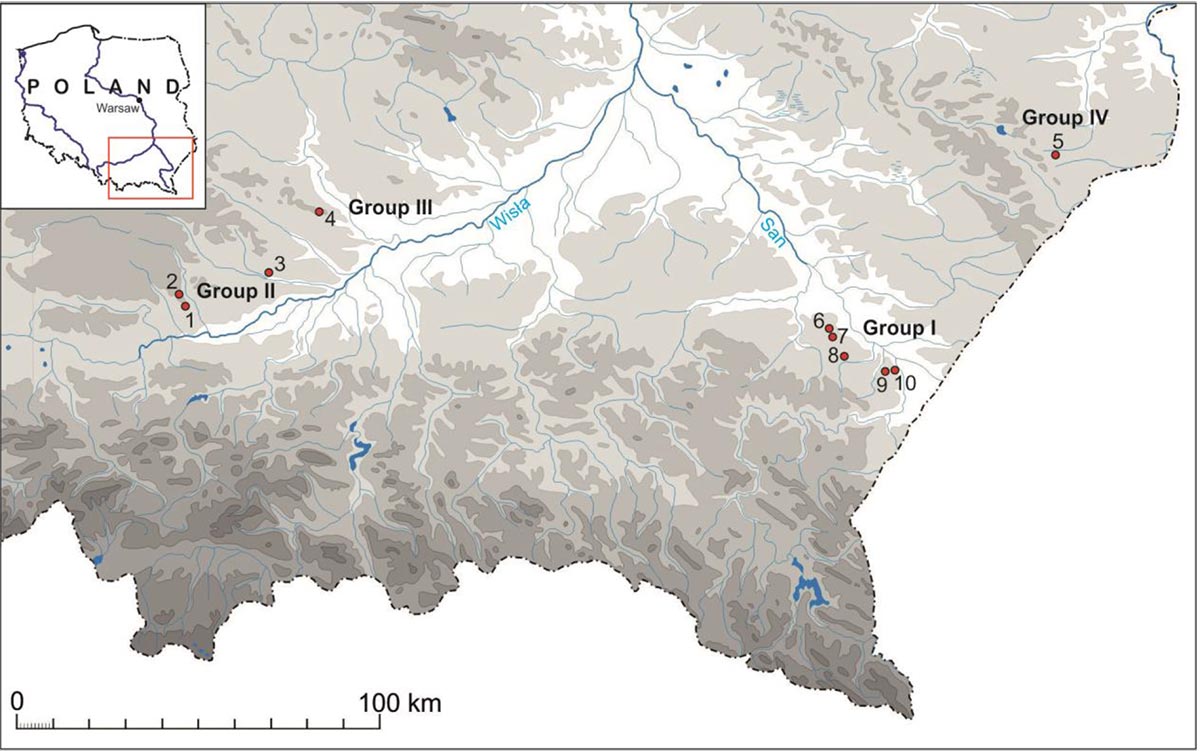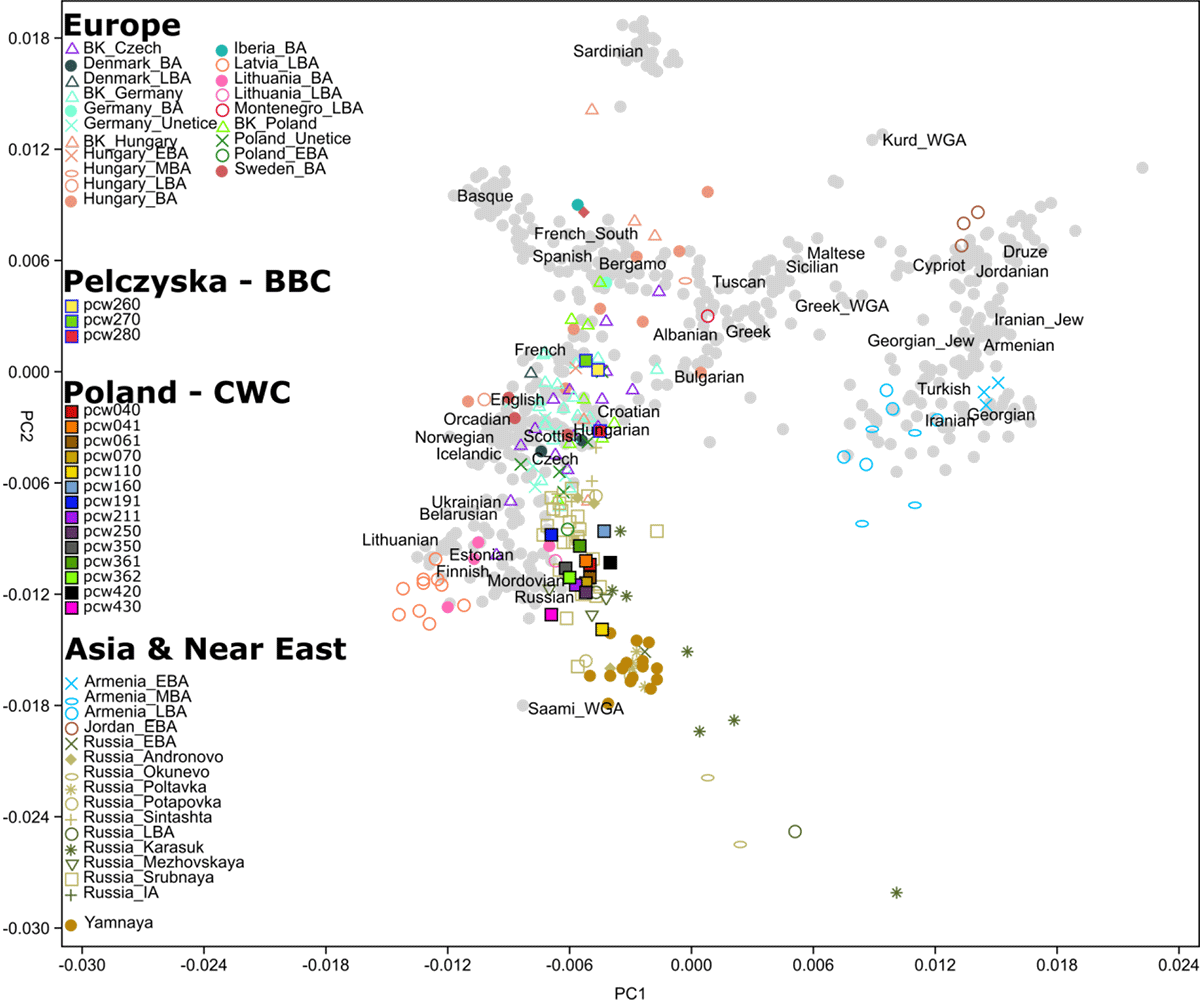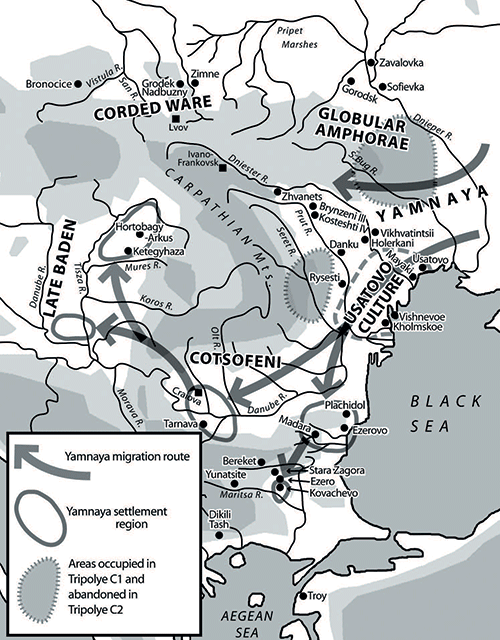Open access Corded Ware cultural complexity uncovered using genomic and isotopic analysis from south-eastern Poland, by Linderholm et al. Scientific Reports (2020).
Interesting excerpts (emphasis mine):
We have obtained genetic data from 19 individuals (16 of CWC and 3 of BBC). All examined individuals come from three geographical regions: the Rzeszów Foothills (part of the Subcarpathian Region; sites of Szczytna, Chłopice, Mirocin and Święte), the Małopolska Upland (Mistrzejowice, Proszowice, Bosutów, Pełczyska) and the Sokal Ridge (the western part of Volhynian Upland – site of Łubcze). All burials are of similar type exhibiting the same funeral rite with some differences concerning grave goods and their radiocarbon dates coincide.

Haplogroups
All Eneolithic individuals from Poland carried mtDNA lineages of European or West Eurasian origin including H (including H2 and H7), HV, I2, J1, K1, T1, T2, U4, and U5. Individuals from Pełczyska exhibited the same mtDNA haplogroups identified at other CWC sites. In contrast to individuals of the Yamnaya complex the CWC and BBC individuals from southern Poland carried I2 and J1 lineages, but lacked the mtDNA haplogroups W and U2, often found in Yamnaya individuals.
In seven individuals the Y chromosome haplogroup was further narrowed down to lineage R1b-M269 or R-L11 characteristic of Yamnaya and Bell Beaker individuals, and particularly widespread throughout Eurasia since the Bronze Age.
Local and nonlocal individuals
According to 87Sr/86Sr values some of individuals buried at sites in the Rzeszów Foothills are non-locals with signatures below 0.710341. While the dietary patterns of those individuals are consistent with CWC background, the archaeological and isotopic data indicate that their place of provenience (e.g. where they spent their childhood) could have been partly the Sokal Ridge or Ukraine.
When the dataset was divided into five groups (with individuals from Rzeszów Foothills divided into local and non-local group) we indeed observed that non-local individuals from Rzeszów Foothills are closest to individuals from the Sokal Ridge and both present very similar patterns in relation to other groups. However, [] we detect no evidence of Group V constituting a uniform well-defined subgroup based on nucleotide diversity tests (…)

Relationship
In order to investigate mutual relations between individuals we employed conditional nucleotide diversity estimates which is calculated between all pairs of individuals investigated in this study. The results did not reveal strong structuring between sites but highlighted closer relationships between a number of individuals (pcw040-pcw041, pcw061-pcw062 and pcw211-pcw212). Additionally, reduced conditional diversity was observed between an individual from Proszowice (pcw420) and individuals from Święte (pcw062, pcw110) and Skołoszów (pcw191).

PCA
The PCA suggests that (a) despite geographical proximity there is a distinct genetic separation between CWC and BBC individuals from Southern Poland. (b) the genetic variation of CWC individuals from southern Poland overlaps with the majority of the published CWC individuals from Germany while the eight published CWC individuals from Poland show a closer similarity to BBC representatives (c) the genetic variation of BBC individuals from southern Poland overlaps with the broad variation of BBC individuals from Central Europe (Czech Republic, Germany, Poland and Hungary).

f2-, f3- and f4-statistics
We tested with outgroup f3-statistics, which ancient population/individuals shared more genetic drift with the ancient samples generated here individually. The different population size between the reference ancient population/individuals and the lack of significant results between closely related individuals and populations make it difficult to extract conclusions from these analyses.
Overall, although non-significant the results suggested a trend where the four groups share more genetic drift with Russia_Afanasievo than with Yamnaya and Groups I, II and III share more genetic drift with Poland_CW than with Russian_Afanasievo. This pattern was also mirrored by the f2-statistics.
Conclusions
Our results would indicate a stronger continuity with earlier Neolithic populations than previously observed. In other words, our study detected traces of an evident “incorporation” of local individuals into the migrating groups. However, the funerary rituals seem to have been affected in limited extent as the burials exhibit the typical CWC pattern in all cases examined.
Compared to the Early and Middle Neolithic samples it seems that the CWC groups I, II and IV are equally distant from the Yamnaya pastoralists and from most of the earlier published Corded Ware groups from Estonia, Germany, Lithuania and central Poland. The south-eastern Polish CWC individuals are significantly more closely related to Yamnaya than to CWC individuals from the Polish lowland supporting the differentiation between various CWC groups from Central Europe. This is in coincidence with archaeological finds that show differences between lowlands and uplands materials of CWC.
Bell Beaker individuals from Pełczyska mostly favour German, Polish (lowland) and Estonian CWC as well as German and Czech Bell Beaker populations over Steppe ancestors. Interestingly, in contrast to CWC individuals from south-eastern Poland (Group I, II and IV), they share significantly closer affinity to Neolithic Iberian, Italian, Hungarian, Swedish, Polish TRB and Brześć Kujawski group populations (and nonsignificant but positive affinity to Polish Globular Amphora) than Yamnaya, pointing to possible continuity between this group and earlier populations.

Comments
Data from these late Corded Ware individuals contradicts our traditional understanding of the Corded Ware culture as a rigid, culturally and genetically homogeneous block of migrants, and corroborates the previous finds of Fernandes et al. (2018) and Malström et al. (2019), where Corded Ware groups showed diverse lineages and/or integration with local groups.
Together with the recent R1b-P310 from Afanasievo in Mongolia, these R1b-P310 samples (and potentially downstream subclades, in line with SNP estimates by Iain McDonald) had a most likely origin in the R1b-rich Don-Volga Proto-Indo-European homeland, further supporting the evident association of R1b-L23 bottlenecks with an Indo-Tocharian-speaking Late Repin.
The most parsimonious explanation to all phylogenetic and cultural data combined is that these R1b-L51 lineages were already part of the Late Repin/Early Yamnaya settlers that spread west through the north Pontic area ca. 3350/3100 BC, a part of them likely becoming incorporated into the Late Trypillian groups that eventually formed the Corded Ware culture.
A) In favour of a recent origin of these lineages in Catacomb migrants from the south-east are the isotopic signature of some samples (and potential paternal link of all groups), their late date, the lack of other R1b-L23 haplogroups in other sampled Corded Ware groups, as well as the cultural similarity to Catacomb. This could potentially be used to support a more than dubious “Indo-Slavonic” split, since a Catacomb-related community could have infiltrated Corded Ware in South-West Poland to eventually become the origin of Balto-Slavic, as Poltavka developed into the Pre-Indo-Iranian community.

A. 6th and 5th mill. BC. Foll. Kadrow, Zakościelna 2000; Larina, Okhrimenko 2007; Kośko/Szmyt 2009. Key: a – borders of east European ecological zones; b – Western Bug-Dniester limes; c – range of Janisławice – Rudoy Ostrov cultural circle; d – range of Linear Pottery culture settlement; e – range of Malice culture settlement; f – range of Lublin-Volhynia culture settlement.
B. 4th mill. BC. Foll. Szmyt 1999a; Pelisiak 2007; Kośko, Szmyt 2009; Rybicka 2017; Szmyt 2013a. Key: a – borders of east European ecological zones; b – Western Bug-Dniester limes; c – range of FBC settlement; d – areas of reception of “Trypillian” patterns by FBC populations; e – range of late TC settlement; f – areas of reception of FBC patterns by TC populations; g – range of Pre-Yamnaya groups.
C. 3rd mill. BC. Foll. Szmyt 1999a; Kośko, Szmyt 2009; Szmyt 2013a. Key: a – borders of east European ecological zones; b – Western Bug-Dniester limes; c – range of GAC settlement (eastern group: V – Volhynian subgroup; P – Podolian subgroup; S – Moldavian subgroup); d – isolated sites of GAC; e – range of CWC circle; f – range of Yamnaya culture; g – range of Middle Dnieper culture.
D. Pontic impact in the 3rd mill. BC. Foll. Włodarczak 2006b; Kośko, Szmyt 2009; Machnik 2009; Szmyt 2013a. Key: a – borders of east European ecological zones; b – Western Bug-Dniester limes; c – range of Yamnaya culture; d – range of Middle Dnieper culture; e – range of Catacomb culture; f – range of GAC; g – range of CWC circle; h – areas of reception of Pontic patterns (ZC = Złota culture; CS = Cracow-Sandomierz CWC group; SG = Sokal group; K = Kujawy; C – Chełmno land); i – finds of Pontic origin on the Baltic.
B) However, data in favour of the – more likely – ancestral origin of these lineages in late Repin/Early Yamnaya settlers migrating through the north Pontic area (starting ca. 3350 BC, including slightly later Yamnaya vanguard settlers), eventually integrated within Late Trypillian/Proto-Corded Ware groups, include:
- Their homogeneous Corded Ware ancestry, showing a potential direct source in Late Trypillia (as suggested by the closer affinity to Afanasievo than to Yamnaya, hence a likely WSHG-like pull), with sample pcw110 showing a position close to the Yamnaya cluster – probably similar then to the early CWC sample poz81 from Obłaczkowo (ca. 2900-2600 BC). The early infiltration of Proto-Indo-European lineages into a Steppe Maykop-like community might help explain why some early-splitting Corded Ware groups show a variable affinity for a Yamnaya source.
- A prevalence of archaic “western” R1b-L51 lineages, instead of the R1b-Z2103 proper of Catacomb (and of most Yamnaya and Afanasievo individuals), also suggests that these were part of a quite early wave of migrants unaffected by later bottlenecks under R1b-Z2103. Even though we don’t yet have detailed information on Palaeo-Balkan groups, this heartland of the Corded Ware culture looks like a late sink of R1b-L51, instead of a varied source of Yamnaya haplogroups (including a plurality of R1b-L23 subclades, and also I2-L699, Q1, or J1), a variability that is visible among Afanasievo and Yamnaya, but also still among East Bell Beakers.
- According to Włodarczak (2018), whereas the origins of niche (catacomb) grave constructions in the Złota culture would seem to be related to the influences of the pre-Yamnaya groups (eventually also of Late Trypillia – Usatovo), their subsequent evolution in the Kraków-Sandomierz group was the result of local changes, which led to a differentiation and transformation from Steppe cultural patterns, which is not suggestive of late migrations:
Around 2600/2550 BCE new elements appeared in the funeral ritual of the Małopolska CWC societies, indicating contacts with the rites and practices of the Eastern European communities. The most important expression is the niche (catacomb) form of the grave construction. The idea – or analogies – of such a structure in the graves was already present in the earlier period in the Złota type cemeteries – ca. 2900-2600 BCE. In this phase specific types of constructions appeared with good analogies in the features of the Catacombnaya culture in the North-Pontic zone. Along with the new constructions, modifications of the burial arrangement, the orientation of the body and the burial equipment were made. Single graves dominate, although the number of double and multiple burials is noteworthy. In comparison with other regions of Central Europe, the Małopolska burials are equipped with particularly rich sets of gifts. Particularly specific is the nature of the equipment in some graves of adult men, which include ceramic vessels (the main type is a large beaker with a distinct neck), weaponry (stone battle axes and arrowheads), sets of flint tools (mainly axes, knife inserts and strikers), bone, antler implements, stone implements (whetstones and grinding discs), copper tools and ornaments (including characteristic copper hair-rings), as well as “half-finished” items implements of flint. Thus, such burials emphasize the role of a man as a warrior, as well as a craftsman-specialist, whereas in the Małopolska materials the specialization in the field of flint making is especially emphasized. Unlike in other Central European CWC groups, at Małopolska there are numerous burials of men equipped with triangular arrowheads (up to 30 pieces). In other areas, the archery sets as an important element of the burial equipment of the deceased appears about 100-200 years later associated with the appearance and spread of the BBC ritual.
An early infiltration of pre-North-West Indo-European-speaking peoples within a Late Uralic-speaking Proto-Corded Ware would finally give support in linguistics to the earliest layer of Late PIE borrowings in Uralic (first proposed by Koivulehto), including – otherwise difficult to explain – pre-NWIE loans common to all Finno-Ugric dialects (see e.g. the recent Holopainen 2019). This substrate–superstrate scheme seems much more precise than an areal diffusion through loose contacts between the Pontic forest-steppes and the Don–Volga area, as I had to propose until now.
It would also confirm, at least in the archaeological aspect, the picture drawn by Anthony (2007) of the Late Eneolithic “Dark Age” in the north-west Pontic area, with Yamnaya chieftains becoming integrated among dispersing Late Trypillians. This could also help explain their cultural transition to oxcart-based cattle herding, horseback riding, and a mobile economy more proper of the Yamnaya:
(…) integrated culture appeared in the Dniester valley just after the abandonment of all the Tripolye C1 towns in the South Bug valley on one side and the final Cucuteni B2 towns in southern Romania on the other. The chaos caused by the dissolution of hundreds of Cucuteni-Tripolye farming communities probably convinced the Tripolye townspeople of the middle Dniester valley to accept the status of clients.
Their relationship with the Tripolye villages in the Prut and Dniester forest-steppe seems unequal. Kurgan graves and graves containing weapons occurred only in the steppe. The upland Vikhvatinskii cemetery contained female figurines, but no metal weapons and only one copper object, a simple awl. Probably the Usatovo chiefs were patrons who received tribute, including fine painted pottery, from upland Tripolye clients. This relationship would have provided a prestige and status gradient that encouraged the adoption of the Usatovo language by late Tripolye villagers.

About Corded Ware:
The material culture of the Corded Ware horizon was mostly native to northern Europe, but the underlying behaviors were very similar to those of the Yamnaya horizon – the broad adoption of a herding economy based on mobility (using ox-drawn wagons and horses), and a corresponding rise in the ritual prestige and value of livestock. The economy and political structure of the Corded Ware horizon certainly was influenced by what had emerged earlier in the steppes, and, as I just argued, some Corded Ware groups in southeastern Poland might have evolved from Indo-European-speaking late TRB societies through connections with Usatovo and late Tripolye. The Yamnaya and Corded Ware horizons bordered each other in the hills between Lvov and Ivano-Frankovsk, Ukraine, in the upper Dniester piedmont around 2800-2600 BCE.
All in all, it looks like we are getting a reversed traditional picture of Corded Ware and Bell Beakers. From the years where a monolithic R1a-rich Yamnaya→Corded Ware population of “Kurgan peoples” seemed to be the ones influencing a West European R1b-rich Bell Beaker culture through infiltration and acculturation, it looks like the R1b-rich Yamnaya were the ones strongly influencing the development of genetically diverse Pre-Corded Ware and Corded Ware societies, while R1b-rich Bell Beakers expanded explosively slightly later, culturally unifying most European areas occupied by late Corded Ware groups.
The radical cultural changes of the Pre-Corded Ware population from agriculture to nomadic pastoralism, and a later return of regional Corded Ware groups to hunting-gathering-fishing subsistence economies in Fennoscandia and the Forest Zone, as well as the multiple admixture events including Y-DNA infiltrations and bottlenecks, shows a resilience and ability to adapt among the (Pre-)Corded Ware groups that contrasts heavily with the tight family ties and consistent subsistence economy of Yamnaya-related populations during the same period (roughly ca. 3500-2200 BC).
See also
- On the origin of haplogroup R1b-L51 in late Repin / early Yamna settlers
- Fully Steppe-like Proto-Corded Ware Late Trypillians
- Earliest R1a-Z93…from Late Trypillia in the Podolian-Volhynian Upland!
- “Steppe ancestry” step by step (2019): Mesolithic to Early Bronze Age Eurasia
- Bell Beakers and Mycenaeans from Yamnaya; Corded Ware from the forest steppe
- On the Ukraine Eneolithic outlier I6561 from Alexandria
- Yamnaya replaced Europeans, but admixed heavily as they spread to Asia